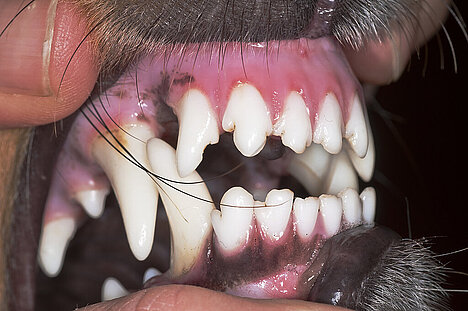Pentasodium triphosphate

Pentasodium triphosphate is a chemical that is found in many foods and cleaning agents. But what does it have to do with dogs? In this article, you'll find out what pentasodium triphosphate is, how it affects your dog and what the advantages and disadvantages are.
What is pentasodium triphosphate?
Pentasodium triphosphate is a salt of phosphoric acid that consists of five sodium ions and three phosphate ions. It has the formula Na5P3O10 and is also known as sodium tripolyphosphate or E451. Pentasodium triphosphate is a white powder that dissolves well in water and forms an alkaline solution.
Pentasodium triphosphate is used in the food industry as an emulsifier, stabilizer, preservative and texture improver. For example, it prevents fat and water from separating in meat products or crystals from forming in ice cream. Pentasodium triphosphate is also used in detergents to reduce water hardness and remove dirt.
How does pentasodium triphosphate affect dogs?
Pentasodium triphosphate can also be found in dog food, especially in dry food. The main reason for this is that pentasodium triphosphate can prevent or reduce the formation of tartar in dogs. Tartar is a hard layer of bacteria and minerals that builds up on the teeth and can lead to gum inflammation, bad breath and tooth loss. Pentasodium triphosphate binds to the calcium in the saliva and prevents it from combining with the phosphate in the food to form tartar.
However, pentasodium triphosphate can also have negative effects on dogs. On the one hand, it can lead to an oversupply of phosphorus, which can impair kidney function. On the other hand, it can lead to an undersupply of calcium, which can impair bone and dental health. In addition, pentasodium triphosphate can cause gastrointestinal problems such as diarrhea or vomiting in sensitive dogs.
What are the advantagesand disadvantages of pentasodium triphosphate?
The advantages and disadvantages of pentasodium triphosphate for dogs can be summarized as follows:
Advantages
- Can prevent or reduce the formation of tartar
- Can improve the shelf life and quality of dog food
Disadvantages
- May impair kidney function
- May affect bone and dental health
- May cause gastrointestinal discomfort
How can you decide?
Whether or not you want to give your dog food with pentasodium triphosphate depends on various factors. For example, you should look at how much pentasodium triphosphate is in the food, how old your dog is, whether he has any health problems and whether he is getting other sources of calcium or phosphorus. You should also be aware of the alternatives to pentasodium triphosphate, such as natural teeth cleaners or special dental care products for dogs.
Pentasodium triphosphate, also known as sodium tripolyphosphate or E451, is a salt of phosphoric acid that is used in the food industry as an emulsifier, stabilizer and preservative. In dog food, especially dry food, it can be used to prevent tartar build-up as it reduces the formation of tartar by inhibiting the combination of calcium and phosphate in saliva. However, the use of pentasodium triphosphate can also have disadvantages, such as possible impairment of kidney function and bone and dental health. The decision whether or not to give it to your dog should depend on various factors.
If you notice any signs of hypersensitivity or poisoning in your dog, you should see your vet immediately. We are not a substitute for a vet, but we try to be as accurate as possible. Every dog reacts differently and we recommend you get a second opinion or consult your vet if in doubt.
Stay healthy and take good care of your four-legged friend!😊